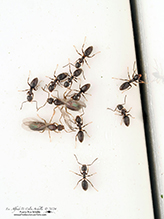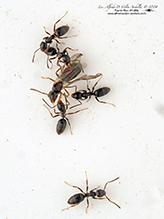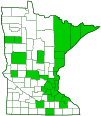odorous house ant
(Tapinoma sessile)
Conservation • Description • Habitat • Ecology • Distribution • Taxonomy
|
|
||||||||||||||
Description |
Odorous house ant, often called sugar ant, is a common, small, sweet-seeking ant. It occurs throughout the United States and southern Canada, but it is uncommon in the Great Plains, and it is mostly absent from the Great Basin. It also occurs in Mexico. Odorous house ants are extremely adaptable, and they are found in virtually all habitats. They are most common in grasslands, near rivers, and in disturbed areas. They build nests in the ground under and within objects, and in downed wood. They feed on honeydew from aphids and scale insects and on flower nectar. They are also common in houses, in other human structures, and in mulch piles. In houses, they nest wherever there is adequate moisture, including near pipes, drains, toilets, and heaters. They feed on sugary substances left on the kitchen counter and on other sources of sweets. Odorous house ants form small colonies with a single nest, a single queen, and a few hundred workers, to large colonies with multiple nests, multiple queens, and thousands of workers. Odorous house ants do not have a stinger. When crushed, they produce a pungent odor of rotten coconuts or over-ripe bananas. This is the feature that gives this species and the Subfamily Dolichoderinae their common names. The worker is ⅛″ (2.39 to 3.19 mm) in length. The body is dark brown to black and slightly glossy. It is covered with short, fine, grayish, closely appressed hairs, giving it a slightly dusted (pruinose) appearance. The front part of the body is connected to the rear part by a single, distinct, narrow segment (petiole). There is no postpetiole. The head is slightly longer than wide. The antennae have 12 segments, and they are not expanded (clubbed) at the end. The basal segment (scape) is very long. The remaining segments, collectively called the funiculus, join the scape at a sharp angle, giving the antennae a sharply elbowed look. The jaws (mandibles) have 10 or more teeth. The four closest to the tip are longer than the others, and the fourth from the tip is the longest. The antennae and the mandibles are brown, lighter than the body. The front part of the body (mesosoma) is short and robust. There are three upper exoskeletal plates on the mesosoma, each forming a distinct bump. The first plate (pronotum) and second plate (mesonotum) cover the thorax. The third plate (propodeum) covers the first segment of the abdomen which is fused to the thorax. The grooves between the plates are very distinct. When viewed from the side, the pronotum and mesonotum form a smooth, continuous arch. The petiole does not have a raised bump (node). The rear part of the body (gaster) is egg-shaped, broadest at the base and tapering to the tip. It has four visible segments. The upper side of the fourth segment has several long, yellowish, erect hairs. The legs are brown, lighter than the body. |
Size |
Worker total length: ⅛″ (2.39 to 3.19 mm) Wingless female total length: ⅛″ to 3⁄16″ (3.75 to 4.29 mm) Winged male total length: ⅛″ to 3⁄16″ (3.60 to 4.44 mm) |
Similar Species |
Habitat |
Grasslands, near rivers, disturbed sites, and houses |
Ecology |
Season |
Early spring to late fall |
Behavior |
|
Life Cycle |
|
Larva Food |
|
Adult Food |
Honeydew from aphids and scale insects, flower nectar, sugar |
Distribution |
||
|
Sources |
|
| 2/12/2025 | ||
Occurrence |
||
Common |
||
Taxonomy |
|
Order |
Hymenoptera (Ants, Bees, Wasps, and Sawflies) |
Suborder |
Apocrita (Narrow-waisted Wasps, Ants, and Bees) |
Infraorder |
Aculeata (Ants, Bees, and Stinging Wasps) |
Superfamily |
Formicoidea (ants) |
Family |
Formicidae (ants) |
Subfamily |
Dolichoderinae (odorous ants) |
Tribe |
Tapinomini |
Genus |
Tapinoma |
Subordinate Taxa |
|
|
|
Synonyms |
|
Formica gracilis Formica parva Formica sessilis Tapinoma boreale Tapinoma dimmocki Tapinoma sessilis |
|
Common Names |
|
coconut ant odorous house ant stink ant sugar ant the odorous house ant |
|
Glossary
Gaster
The bulbous part of the abdomen of ants, bees, and wasps. In ants it usually begins at segment three.
Mesosoma
In Hymenoptera: the front part of the body, consisting of all three segments of the thorax and the first segment of the abdomen, to which the wings are attached.
Petiole
On plants: The stalk of a leaf blade or a compound leaf that attaches it to the stem. On ants and wasps: The constricted first one or two segments of the rear part of the body.
Propodeum
In Hymenoptera: the last segment of the thorax, anatomically the first segment of the abdomen.
Scape
In plants: An erect, leafless stalk growing from the rootstock and supporting a flower or a flower cluster. In insects: The basal segment of the antenna.
Visitor Photos |
||
Share your photo of this insect. |
||
This button not working for you? |
||
Alfredo Colon |
||
 |
 |
|
MinnesotaSeasons.com Photos |
||
|
||
|
||

Slideshows |
|

Visitor Videos |
||
Share your video of this insect. |
||
This button not working for you? |
||
|
Other Videos |
||
|

|
Created: 2/12/2025 Last Updated: © MinnesotaSeasons.com. All rights reserved. |


